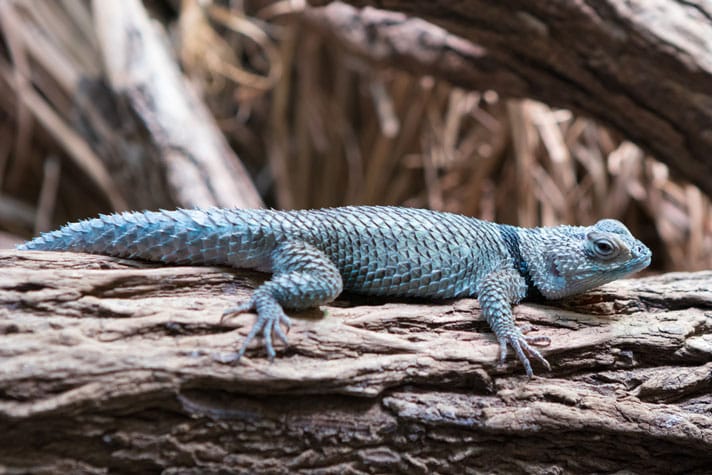Updated February 3, 2023 Blue Spiny Lizard (Sceloporus cyanogenys) Although occasional wild-collected blue spiny lizards may give birth to young
Updated February 3, 2023
Blue Spiny Lizard (Sceloporus cyanogenys)
Although occasional wild-collected blue spiny lizards may give birth to young in captivity, this beautiful lizard has not yet been truly captive bred. This care sheet offers suggestions on reptile supplies and husbandry.
Blue Spiny Lizard Description
Although the body is somewhat flattened, this lizard is of moderately robust build.
This lizard is sexually dimorphic with females being the smaller and less colorful sex. Adult males are grayish blue dorsally, rich blue laterally, have a single black collar edged with lighter scales both anteriorly and posteriorly and containing a bright blue spot on each shoulder. Males also have a banded tail, prominent blue belly patches and a blue throat. The head and limbs are gray to brown. Males are especially bright during the breeding season. Adult females and the young of both sexes are grayish or brown and lack most of the blue highlights, including the blue belly and throat patches.
Blue Spiny Lizard Size
Having an overall length of up to 14 ¼ inches (of which nearly 8 inches is tail length) this is the largest of the spiny lizards to occur in the United States.
Blue Spiny Lizard Availability
This lizard has not yet been bred in captivity. They are seldom seen on the price lists of reptile dealers. It is possible, using stealth and a lizard stick/noose to collect blue spiny lizards from the wild. Always check local laws and regulations before capturing wild reptiles.
Blue Spiny Lizard Life Span
Captives have lived for nearly 7 years. The longevity of this lizard has not been ascertained in the wild.
Blue Spiny Lizard Range and Habitat
Blue spiny lizards are especially numerous in the boulders near Falcon Dam (north of Roma, Texas) then northward in the rocky, dusty, sizzling, border country to the vicinity of Del Rio, Texas. Besides its preferred habitat of the boulder fields and rocky escarpments of south-Texas and northern Mexico, this lizard may also be seen on deserted buildings, bridge abutments, and similar man-made structures.
Blue Spiny Lizard Caging
A 36 to 50 reptile terrarium (or larger) capacity cage/terrarium will be needed for this active, fast moving lizard species.
Blue Spiny Lizard Lighting & Temperature
Full spectrum cage lighting will be needed for this diurnal, basking, lizard. Because full-spectrum bulbs produce only small amounts of the desired ultraviolet rays (UV-A and UV-B), the basking platform must be 12 inches or less from the bulb. Follow the instructions provided with your bulbs carefully and use proper reptile light fixtures. Cage temperature 80-88F days, 70-80F nights. Basking (hot) spot temperature 100-108F, use daytime only and use reptile thermometers to monitor the conditions.
Blue Spiny Lizard Substrate and Furnishings
For lizard habitat products, small rocks mixed with coarse sand is the preferred substrate for this saxicolous desert lizard. Flat rocks (such as shale), diagonal and horizontal, and placed within the specifications of your full spectrum bulb are the preferred furnishings.
Blue Spiny Lizard Food
This is an insectivorous lizard species, so they feed on live reptile food. Giant mealworms (Zoophobas), regular mealworms (Tenebrio), waxworms (Galleria), crickets (Acheta), silkworms (Bombyx) and other non-noxious caterpillars, and various small roaches of several genera, are all commercially available and excellent food items. If you have nearby fields or meadows that have not been subjected to insecticides, “field plankton”, insects collected with a sweepnet can be collected during the warm months. A diet consisting of varied insect species is better for the lizards than a diet of only one or two insect species. Of importance also is to choose insects of the proper size. All offered insects should be relatively small when compared to the lizard’s head in size. Even if ample full spectrum lighting is provided, except for freshly collected field plankton, your feed insects should be dusted periodically with a vitamin D3-calcium powder. Suggested intervals for the dusting would be 10 days to 2 weeks for adult lizards and weekly for growing lizards.
Blue Spiny Lizard Water
A shallow, firmly settled reptile water dish should be kept filled with fresh water at all times. If water should spill or splash replace the substrate as needed.
Blue Spiny Lizard Handling and Temperament
This magnificent spiny lizard should be considered a display species and not a “pet” lizard in the commonly thought of handleable sense. They can be handled when necessary but may attempt to bite or escape. Use care. Encircle the lizard’s body from neck to cloaca with palm and fingers. Grasping or restraining the lizard by the tail may cause the tail to autotomize (break off). Broken tails will partially regenerate but always visibly differ from the original in structure and scalation.



